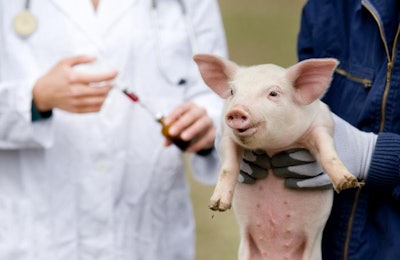
Researchers at the University of Veterinary Medicine (Vetmeduni) in Vienna, Austria, have discovered a new pig virus as the cause of “shaking piglets” or congenital tremor, a syndrome that leads to a heavy losses among infected litters. This discovery can be used to identify problem herds, and to the prospect of pig vaccination as a means to control the disease.
In January of 2015, a small-scale pig breeder in Austria observed an increase in the number of piglets born with such severe lateral shaking of the whole body that they were unable to suckle milk, according to the scientific paper by Benjamin Lamp and others published in the current issue of Emerging Infectious Diseases.
The authors report that the prevalence of the shaking was between 20 and 100 percent in affected litters. Although the outbreak stopped in July of that year, the farm’s productivity had been severely reduced - just 22.4 piglets weaned per sow and year for that period compared with the farm’s previous performance of 25.8 piglets – and resulted in huge financial losses to the farmer.
Postmortem examination of infected piglets revealed severe damage to the brain and spinal cord typical of that observed with the type A-11 form of congenital tremor. Older pigs at the farm showed no clinical symptoms.
Novel pestivirus identified
As a result of their investigations at the affected farm, Vetmeduni scientists identified a new pestivirus as the cause of the shaking. A member of the Flaviviridae family, it has been provisionally named LINDA virus (Lateral shaking Inducing Neuro-Degenerative Agent).
“The new PCR assay our team developed recognized all known pestiviruses,” said Lamp of the Vetmeduni’s Institute of Virology, in a press release, “and so enabled us to detect a virus that was previously unknown.”
His team is now developing a serological test to ascertain the prevalence of the LINDA virus in Austria, and assess the threat it poses to the country’s pig breeders.
Having established tests to identify the LINDA virus, the Vienna-based researchers were able to detect it in the saliva and semen of mature pigs at the farm, leading them to propose that the disease may be sexually transmitted, according to a related paper they published in Veterinary Research.
Dangerous relations
The LINDA virus is closely related to the atypical porcine pestiviruses (APPVs), which were discovered recently in North America and, later detected in Europe, the Vetmeduni group reports. It is also similar to the classical swine fever virus, which causes damage to the spinal cord.
LINDA’s closest relative, however, is a pestivirus that was first detected in 2003 on a commercial pig breeding farm in Australia. Later termed Bungowallah virus, it caused abortions, stillbirth and sudden death, and eventually led to the loss of around 50,000 animals on the two farms affected. This virus has never been detected anywhere else.
While pestiviruses are quite common in cattle, sheep and pigs, they do not pose a threat to human health.
Previous research at the Swedish University of Agricultural Sciences in 2014 overturned an earlier hypothesis that congenital tremor was caused by the porcine circovirus type 2 (PCV2) virus, and proposed that the pathogen may be an astrovirus.

















